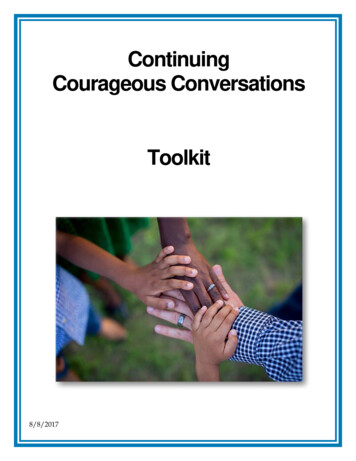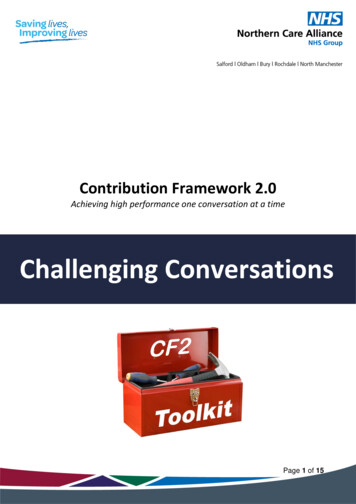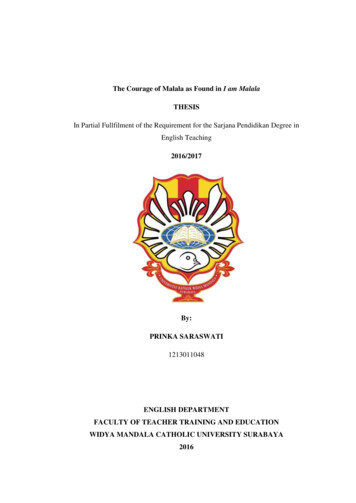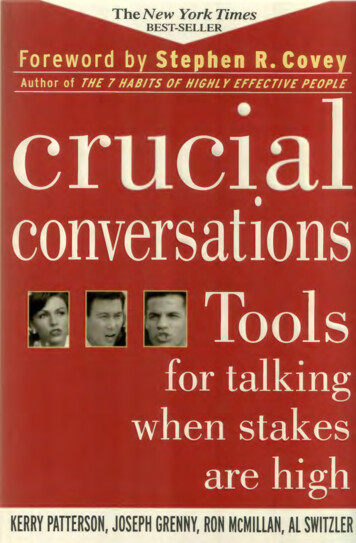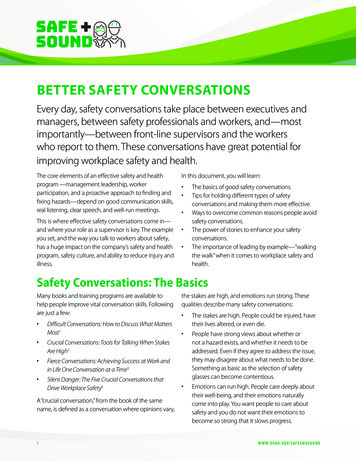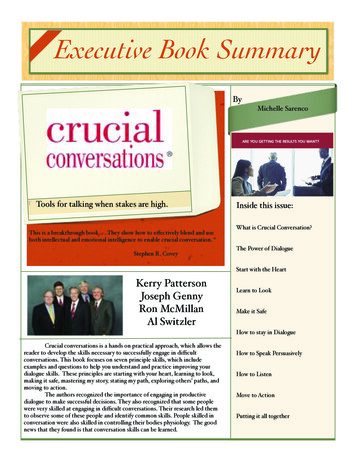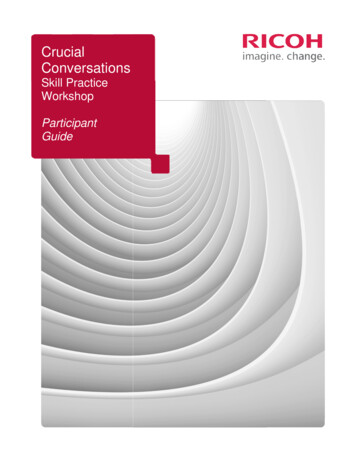
Transcription
To Serve and Protect theInterest of Fire DistrictsVOL.ISSUEApril - June 2011Courageous ConversationsBy Chief Marc Revere CFC, CFO, EFO, Novato Fire Protection DistrictAs chief, you must create a culture where members feel thatthey can speak openly about personal and organizationalshortcomings. How many of us have made a decision thatwent wrong—a decision that could have been preventedby someone pulling us aside and sharing a bit of crucialinformation? The words of author and preacher NormanVincent Peale come to mind: “The trouble with most of usis that we would rather be ruined by praise than saved bycriticism.”Recently, I read the book “Game Change,” about the 2008presidential campaign. The book illustrated that when JohnEdwards was running for president, his staff really wanted tohave a “courageous conversation” with him regarding his affairand issues with his wife. I think the conversation might havegone something like this: “Hey boss, we’re working our tailsoff so you can be president, so don’t you think it’s a good ideato (you fill in the blanks).” Assuming Edwards would havelistened, this conversation could have saved his political career.But his staff didn’t have that conversation, and Edwards didn’tbecome president.So what exactly is a courageous conversation? The best wayto describe it is a combination of the Emperor’s New Clothes,the Johari Window, Shared Situational Assessment (SSA) andsome 360-degree feedback. Let’s take a closer look.The Goal: “Courageous” Conversations Reveal Need forImprovementIf we look at the concept of courageous conversationsfrom a rational decision-making prospective, the goal is tohave colleagues, peers and subordinates tell you the truth,when you need to hear it, even if you don’t want to hearit, whether you ask for it or not. This is especially true inconversations where the stakes are high, opinions vary andemotions run strong—as defined in the book “CrucialConversations” by Patterson, Grenyy, McMillian andSwitzler.But before any of this can occur, you must create anenvironment and supportive culture that allows for thesetypes of conversations to exist. The bottom line: How youlisten to bad news and react to it plays a big role in howfuture conversations go.So let’s assume you’re willing to hear bad news and/ora perspective different than yours. How do you makeit known you want to hear this and that others are safein approaching you? First, you need to give permissionto your staff and/or close advisors. This doesn’t meanallowing members to be disrespectful or irreverent, butthey should understand that they don’t have to be in awecontinued on page 4
Vol. 7 Issue 2Board of DirectorsPresidentKevin Wallace1st Vice PresidentSteve Kovacs2nd Vice PresidentKeith LarkinTreasurerRobert GillImmediate Past PresidentCherie RitaExecutive DirectorCatherine SmithZone DirectorsNorthern Zone 12011-13Howard Wood, ChiefVacaville FPDNorthern Zone 12010-12James Hill, DirectorCloverdale FPDNorthern Zone 22011-13Richard Webb, ChiefLinda FPDNorthern Zone 22010-12Cherie Rita, ChiefWest Plainfield FPDNorthern Zone 32011-13Michael Manna, DirectorWoodbridge FPDNorthern Zone 32010-12Todd Cunningham, ChiefDiamond Springs FPDSouthern Zone 42011-13Michael McMurry, ChiefScotts Valley FPDSouthern Zone 42010-12Kevin Wallace, ChiefMontecito FPDSouthern Zone 52010-12Steve Kovacs, ChiefMurphys FPDSouthern Zone 52010-12Keith Larkin, ChiefFresno County FPDSouthern Zone 62011-13Martin Marugg, DirectorAlpine FPDSouthern Zone 62011-13Jeff Willis, ChiefBig Bear City Fire DepartmentAt-Large DirectorsJim Espinosa, DirectorChino Valley Fire DistrictRichard Pearce, ChiefTiburon FPDGreg Durante, DirectorEl Dorado Hills FPDRobert Gill, ChiefPioneer FPDDave Giblin, DirectorSouth Placer Fire District22011-132011-122011-132011-132011-13FDAC Report is published quarterly by the Fire Districts Association of California.Catherine Smith, EditorAshley Bradley, Copy EditorJames Wilfong, Graphic DesignerFDAC1215 K Street, Suite 2290Sacramento, CA 95814(800) 829-4309(916) 231-2141 faxwww.fdac.orgWelcome: FDAC’s Incoming President’s MessageBy Kevin Wallace, Fire Chief, Montecito FireWe have just returnedfrom the FDAC AnnualConference, which providedus with great speakers andan opportunity to networkwith directors, staff, andchief officers. While at theconference, I was presented with a questionabout my worries upon being appointed asthe President for the next year. After very littlethought, I replied that with our executivedirector, her staff, and the members of theboard, we have a great team. Why shouldI worry? Well, the part about a great teammaking me look good still holds. Upon furtherreflection, we do have some worries that will bethe source of many sleepless nights.I recently had the privilege to speak at anacademy graduation of 12 firefighters. Thetheme of my speech was taken from theopening lines of “A Tale of Two Cities” byCharles Dickens. “It was the best of times;it was the worst of times .” Now granted,I had to search for the best of times. Just thefact that we are hiring 12 firefighters is goodnews. Additionally, two agencies, a fire districtand a city fire department, consolidated ourtwo training academies to improve efficiencies,decrease cost, and foster better cooperationamong our personnel. Now our worst timesare not as dire as the French Revolution inthe 18th century, but there are dark cloudslooming over the future of the fire service inCalifornia. The recession has adversely affectedour revenues. Master Mutual Aid, which is thebest disaster response system in the nation, maynot be supported by 20 percent to 30 percentof participants. Our statewide training systemunder the State Fire Marshal’s office is on lifesupport. The State of California is looking foran opportunity to reduce costs and services.In the next few years, we have theopportunity to shape the new fire service.Not because we want to, but because we haveto. We will have to tear down walls that havebuilt up between prevention and operations,big departments and small departments,wildland agencies and urban departments, andvolunteers and paid firefighters. We will needto participate in a process that may be difficultat times, to form a more efficient, collaborativeand engaged fire service. If we are able to dothis well, then we will be able to emerge fromthese worst of times with a product that trulyserves the citizens of California.In the past, FDAC has provided educationalsupport through our Certificate ofAchievement program, our AnnualConference, and access to information onour website. We have provided legislativesupport through the work of Ralph Heimand the Legislative Committee. We now needhelp from our members for input and ideasas the conversation heats up about “smartgovernment” and the fire service future.When proposals come across your desk oremail, I am looking for thoughtful input asto the impacts on your districts. Also, theLegislative Committee may put out a requestfor quick response to support or oppose billsthat are proposed in the senate or assembly.We, like those 12 rookie firefighters, have anopportunity to shape the future of the fireservice and fire districts.
A Message From FDAC’sOutgoing PresidentBy Cherie Rita, West Plainfield Fire DepartmentIt was another successful year for the FireDistricts Association of California and theAnnual Conference was, once again, a hugesuccess. Nearly 100 members attended,enjoying topics ranging from keeping moraleup while finances are down to planning forfacilities, apparatus and equipment needs.Membership remains steady and we continue our efforts tosecure membership of as many districts as possible. One of ourrecent member benefits is our new membership database andregistration site. Members are able to register for classes andconferences online, as well as pay member dues. If you cannotremember your username and password, call the FDAC officeand Justin or Brandon will be happy to help you.DO YOU HAVE A STORY TO SHARE?Is your fire district doing something unique? Whether it’s agreat new program or how you managed a complex issue,we want to hear about it. The FDAC Report is distributed tomembers statewide and fire districts located throughout California — from Siskiyou to San Diego. If you have news toshare, contact Copy Editor Ashley Bradley, abradley@fdac.org.The Education Committee was on the road this year, deliveringthe Certificate of Achievement program to a full house at theCloverdale Fire Protection District. We are happy to present aclass at a location near you – just give us a call.The Legislative Committee reviewed and tracked several billsthis past year and is gearing up for the next round. The nextyear will be critical as the state continues to try to find ways tobalance its budget, with potentially disastrous results for specialdistricts. Please, look for call-to-action emails and respondaccordingly.As I turn the presidency over to Kevin Wallace, Fire Chief ofMontecito Fire, I want to thank all of our members – with yourhelp we continue to improve the delivery of emergency servicesin California.FASISYour Workers’ Compensation SolutionThe Fire Districts Association of California – Fire Association SelfInsurance System (FASIS) is a governmental joint powers authoritythat has been serving the workers’ compensation needs for FireDistricts since 1984. FASIS was established for the purpose of selfinsuring its workers’ compensation coverage and establishing acost-effective and comprehensive workers’ compensation program.FASIS provides a long-term alternative to the roller coaster ride inherentto the California commercial workers’ compensation insurance market.Our program is designed to stabilize workers’ compensation costsand provide long-term financial advantage by: Having a large membership (currently over 220 members)creates a greater spread of risk Providing comprehensive risk control services aimed at assistingmembers in identifying loss exposures and implementing theappropriate loss control programs Funding conservatively to cover losses that do arise Maintaining effective and efficient claims administration once claimsoccurAttendees from the Volunteer Leadership Course held in Sacramento.CSFA Conducts Free WorkshopsSee Page 6For more information contact:FASISBickmore Risk Services1831 K Street, Sacramento, CA 95811Telephone - 800.541.4591 / FAX - 916.244.1198 /Website - www.fasisjpa.orgBrian Kelley, Program Director, Ext. 1127, BKelley@BRSrisk.com3
COURAGEOUS CONVERSATIONS (CONTINUED FROM PAGE 1)of you based upon rank. The authors of“Crucial Conversations” note that thosein high-level leadership positions are oftenfrustrated because those around them “filterwhat they say by guessing what they thinkI am willing to hear.” Fire chiefs are nodifferent.Finally, you must be accessible andapproachable to have these types ofconversations. Note that these two termsaren’t interchangeable. You can be veryapproachable, but never around. Andyou can be around all the time, but notapproachable.Three QuestionsCourageous conversations occur at twolevels: organizational and personal. But bothare designed to talk about the elephant inthe room. If you believe you’re not gettingthe necessary feedback from your staff tomake good decisions or understand yourpersonal blind spots, you can draw it out ofthem by asking three simple questions.For an organizational perspective, ask:1. What are three things that we do well?2. What are three things that we couldimprove on?3. If you had a magic wand and couldchange one thing, what would youchange?Once you talk to three or more of yourmembers, regardless of rank, you’ll start tosee themes emerge in the answers.As fire chief, your ability to sense the needsof the organization is important, because itdetermines the direction and organizationalvision of the department. You can only dothis by asking tough, direct questions—and listening to responses that may not beflattering.4If you want personal feedback, ask thesethree questions slightly differently:1. What are three things that I’m doingwell?2. What are three things that I could(should) improve on? Put another way:What do I do that gets in your way?3. If there’s one thing I could change thatwould have a profound professionalimpact on me what would that be?Tip: Only ask these questions if you’re reallyinterested in the answers, or it will be seenas an act of placation. If you listen, followup and thank them—even if you don’t actupon all their recommendations—they willknow you took their opinion seriously, andyou give the signal that you’re open to futurefeedback. Remember: You don’t have to agreewith what others are sharing with you. Butyou do need to know what they think.An ICS AnalogyThe incident command system (ICS) worksby using common procedures and commonterminologies. The same concepts can beapplied to courageous conversations.If someone, starts a conversation bystating that you want to have a courageousconversation this will send a signal regardingthe importance of the next few minutes.Next, size up the scene. Who’s involved?What are the facts? What perspectives dothey bring to the table? How do attitudeschange as the conversation develops? Asin any incident, your size-up should beongoing, and your tactics may need tochange as a result of new information.Finally, you must make decisions on whatto do with the information you collect—in effect, how you solve the problem.Like the fireground scenario, courageousconversations require you to make decisionsbased upon incomplete information, butthese decisions are even more challengingbecause they’re often based on individualperspectives or biases.All employees bring their own interests,wants, desires and needs to the workplace.Although problem-solving is seeminglya rational process, it is also a politicalprocess, which is often irrational.Organizational members seek to satisfynot only organizational interests, but alsotheir own wants and needs. The best way toensure that decisions are not being made insomeone’s self-interest: Ask yourself what’sin the best interest of the community, thefire agency, the members and then yourself.Then identify the facts, assumptionsand bias. This works for personal andorganizational feedback as well for decisionmaking.A Final WordCourageous conversations, whether youinitiate them or they occur through otherswho aren’t afraid to come forward whenthe need arises, allow us to see our personalissues and/or organizational issues clearer.The question you must ask yourself: Whatconversations should we be having butaren’t?Marc Revere is the fire chief of the NovatoFire Protection District, an InternationallyAccredited Agency in Marin County, Calif.He has 34 years in the fire service and is anEFO, CFO and a Harvard Fellow. In 2010,Chief Revere became the first recipient of theRonny Jack Coleman Leadership and LegacyAward from the Commission on Public SafetyExcellence.
Legislative Report: StateBudget UpdateBy Ralph Heim, Legislative AdvocateState Budget UpdateAs the state budget saga is on hold,Governor Brown tours the stateseeking support for his budgetlinchpin, a 5-year extension fora number of taxes set to expire atmidnight on June 30.The Governor had hoped he couldsecure sufficient Republican votesto place the extension on thisJune’s ballot, but after negotiationswith the Republican leadershipcollapsed, any hope of a Juneelection evaporated. The Governoris still optimistic a compromisewith the Republicans can bereached for placement on theNovember ballot.Failing to reach such an agreement, anumber of labor/teacher organizationare considering initiatives for theNovember ballot, one of whichwould contain the Governor’s 5-yearextension of the existing taxes, whileanother may propose to increase thepersonal income tax on California’shighest wage earners.In the interim, don’t expect muchmore on the state budget untilthe Governor releases his MayRevision around mid-May, afterwhich the Governor and Legislaturewill reconvene for serious budgetnegotiations.Legislative Deadline LoomMay 6 was the deadline forpolicy committees to considerbills that must also be consideredby the fiscal committees, so thepace of committee hearingsincreased dramatically andcontinued to do so in order tomeet the May 6 deadline. Thenext important deadline is May27, which is when the fiscalcommittees must take action onfiscal bills, followed by the June3 deadline for bills to pass theirhouse of origin.California Forward ReleasesFinal RecommendationCalifornia Forwardrecently released itsfinal recommendation,including,“Making CaliforniaWork Again: RestructuringState-Local Relationships.”Since these recommendationsaffect every local agency inCalifornia, including thepossibility of reallocating thecurrent property tax allocationformula, the report is certainlya must read. You may view thereport and recommendationsby visiting California Forward’swebsite at www.CAFWD.org.5
CSFA Conducts Free Workshops forVolunteer FirefightersVern Losh, Northern Director, CSFANo one doubts the severity of the currenteconomic crisis the government is facingto provide services. This is not just a local,short term issue, but rather a nationaldilemma. And, nowhere is the issue morecritical than at the local level. This is wheremost services are delivered, especially publicsafety.Specifically, fire districts are challengedby this phenomenon. More importantly,local fire districts are facing anotherchallenge: the need to retain and recruitvolunteer firefighters. Many fire districtsrely on volunteers to staff both firefightingand emergency medical services. It isunfortunate that the economic stresses areoccurring at the same time that the numberof people who become volunteers in fireagencies appears to be declining.The California State Firefighter Association(CSFA) has made an effort to address thischallenge. It applied for and received twoAssistance to Firefighter Grants (AFG)that will assist local fire agencies in doing abetter job of retaining their personnel andrecruiting new members.6The grant is being administered by theRedden Group and is being coordinatedin California by the CSFA VolunteerCommittee. Greg Redden, President ofthe Redden Group states, “This grantprogram is a positive and at the same timecomprehensive effort to give the tools tolocal fire departments in order to maintaintheir level of service.”Ron Coleman, retired State Fire Marshalof California, sits as the Chairman of theVolunteer Committee. His committee is“dedicated to providing support to theentire California Volunteer Fire Servicewithout reservation.” Further he notes that“the retention of volunteers is somethingthat can never be taken for granted. It is ayear round effort and requires concentrationon the value and contributions thatvolunteers make to their communities.”The CSFA and Redden Group areconducting a series of workshopsthroughout the state. The goal is to reachas many volunteers and combination firedepartments as possible.The first of these workshops has alreadybeen conducted in Sacramento inassociation with the CSFA’s AnnualConference. There were more than 40attendees who received information ontopics such as, leadership skills for chiefs,recruitment and retention tips, traininginformation, and much more.The grant provides funding for sixworkshops per year for four years. Theremainder of the workshops for 2011 are setfor May 14 and 15 in Redding, August 13and 14 in Ukiah, September 17 and 18 inBishop, October 15 and 16 in Visalia, andNovember 19 and 20 in San Diego.All expenses to attend the workshops arebeing paid for by AF Grant Funds.Please go to the CSFA website to see specificdetails. www.csfa.netIf your department is totally or partiallyvolunteer, you should have at least onemember in attendance at the next meeting.
Enjoy Grilling, But Stay Safe!Robert L. Gill, Pioneer District Fire Chief/CEOSpring and summer bring the season for Americans to grillburgers, steak and hot dogs. Many of us now fire up the grillssooner in the year and delay putting them away until the firstfrost, and that’s why grill safety is more important than ever.Whether you use charcoal, wood, gas or electricity for grilling,a moment’s inattention can spell disaster, says Pioneer Fire’sChief Robert Gill.To ensure safe cookouts, make sure someone tends the fire at alltimes. Here are some safety tips to consider: Keep grills away from combustibles, including the outside of your house,balcony or garage. Check hose integrity and hose connections to make sure gas is not leakingfrom your gas grill. Apply soapy water to hoses and connections to revealany leaks. Use only equipment bearing the mark of an independent testing laboratory.Follow the manufacturer’s instructions on how to set up the grill andmaintain it. Never store propane cylinders in buildings or garages. If you store a gas grillinside during the winter, disconnect the cylinder and leave it outside. Enforce a “kid-free zone” of 36” around the grill. Also keep your pets fromunderfoot. Never add charcoal starter fluid when coals or kindling have already beenignited, and never use any flammable or combustible liquid other thancharcoal starter fluid to get the fire going. Keep the grill clean.Did You Know? The popularity of gas-fueled grills nearlytripled between 1982 and 1993 (up 193percent from 9.4 million users to 27.5million users). Gas grills have a higher fire risk thancharcoal grills; leaks and breaks are theleading cause, accounting for nearly halfof gas grill fires. Gas-fueled grills caused an estimated600 residential structure fires and 3,200residential outdoor fires in 2001. Charcoal grills have a higher risk than gasgrills of death due to fire or un-ventedcarbon monoxide; most of these deathsdo not involve fire. Charcoal-fueled or other solid-fueledgrills caused an estimated 400 residentialstructure fires and 200 residentialoutdoor fires in 2001. Placing combustibles too close to heat,and leaving cooking unattended, arethe two leading causes for charcoal grillresidential fires. Half of all gas grill and charcoal grillresidential fires begin on an exteriorbalcony or unenclosed porch. Gas fuel is the leading item first ignitedfor residential outdoor gas grill fires. Wall coverings, exterior trim and plantsare the leading items first ignited inresidential outdoor charcoal grill fires.7
FDAC EBAHealth Insurance PoolSince 1972, the Fire Districts Association ofCalifornia (FDAC) has provided Californiafire districts with programs, services andclasses to help the districts they serve andenable their personnel and representativesto become more successful and effective.In 2005, FDAC facilitated the creation of theFDAC Employment Benefits Authority (FDACEBA) in order to offer fire districts a low-costalternative for quality medical, dental, visionand life insurance. Today, more than 45 FDACmember fire districts are taking advantageof these beneÿts:Choice FDAC EBA offers over ten medical plansto choose from for active employees andretirees, including an HSA-compatible PPOand HMO.Savings All participating districts have seen greatersavings over a 3-year period compared toprior carriers.Quality FDAC EBA contracts with top carriers,administration and consultants.Technology FDAC EBA utilizes consolidated billing anduser-friendly online administration.Trust FDAC EBA is the only pool that wasdeveloped by firefighters for firefighters.For more information about the FDAC EBAbenefits package, contact Thoits Insurance at408.792.5447.
conversations where the stakes are high, opinions vary and emotions run strong—as defined in the book “Crucial Conversations” by Patterson, Grenyy, McMillian and Switzler. But before any of this can occur, you must create an environment and supportive culture that allows for these types of
